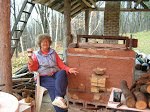.jpg)
.jpg)
After all my troubles with throwing large platters and Steven's comment saying that he was surprised at the trouble that I was having - I decided that I needed more throwing practice and instruction. As I have always wanted to attend a workshop at the Metchosin International Summer School of the Arts just outside of Victoria BC and I saw that Tony Clennel was giving a 2 week throwing workshop there I got all my pennies together and signed up. It was a fabulous experience - Tony Clennel's 2 week course on throwing was just what I needed to get my work up another notch - getting larger in scale, doing handles and paper resists. I highly recommend him for a workshop!
As a bonus John Britt was there doing his glaze course, and there were two raku courses - one with Joe Brecha and the other with Randy Brodnax who demonstrated one evening his throwing techniques. Awesome!
I also took the weekend workshop with Dennis Meiners on textured slabs. As you could wander around to all the other classes I also got to see some of the extruded work by Bill Shinn and the handbuilt paper clay sculptures of Rory McCrory. All this in a paradise setting of Vancouver Island's old growth forest. The building above houses the three pottery classrooms. Our throwing sessions were held on the ground floor classroom.
Here are some of the things that I learnt at MISSA - in no particular order.
1. "If you don't like glazing your pots will show it" (Dennis Meiners). I think he hit the nail right on the head. However how do I get to like glazing? Spraying and overlapping glazes is helping in that respect as it is sort of like painting watercolours.
2. To get rid of an air bubble prick the wall all the way through to the other side.(Tony Clennel) As I am an impatient wedger I often get air bubbles and this solution works well on some of those really stubborn ones.
3. Tony's method of throwing secitonal pots. Throw the bottom section. Let dry a bit and then throw the next section, placing it right away on top, by flipping it by holding onto the bat. Press the sections together and then wire off the bat from the top section. Continue forming the pot. Tony suggests that you do a join where the pot form changes and that will hide any join mark. Before I would let both section set up. This way with the top section being fresh, it is easier to continue forming the shape and so you get a better form.
4. Handle attachments do have a lot of potential for expression. (Tony Clennel)
I have always liked Tony's expressive handles as well as how he treats his attachments, often putting on a "bandaid" over one end of the attachment. See picture of Tony's demo casserole below.)
.jpg)
The asymmetry works well and this gave me lots of new ideas that I have been playing around with.
5. Use a towel, dryer sheet or other smooth fabric to round and smooth the cut edges of slab work to give it a finished look. (Tony and Dennis)I would always use just my finger or damp sponge, but the fabric works much better.
6. On a slab built teapot, place a small coil around the rim so that the lid is lifted a bit - gives a much more finished look. (Denis Meiners)
7. To get a green in reduction, spray on cobalt with a bit of iron and then a light spritzing of rutile on top. (Randy Broadnax) One of the problems in redux firings is that often copper turns pink/red and it is actually difficult to get a good stable green. Haven't tried the Co and rutile yet, but plan to.
8. Use tar paper templates to cut out your slabs and then put the pot together with the paper still stuck on. The paper supports the slab until they are all joined. (Tony Clennel) As I do a lot of hand building I am anxious to try this.
9. When cutting the lid on square closed hand built boxes, bevel the corners when cutting in the opposite directions from the sides. This is will form a lock so the lid does not slide off. (Denis Meiners)
10. Cedar bark makes great brushes. In one of the painting courses students made these great rough brushes from pieces of cedar bark by pounding the bark gently until it shredded. Seems like they would work for some very free loose slip decoration. I tried to find some bark along the shore, but no luck. I will see if our son can find some out there and send me some to try.

1 comment:
I recently returned from a two week workshop with Lana Wilson. John Britt was there as well. Fantastic learning experience. John invited us to look at his classes' test and did a brief glaze info talk.
Post a Comment